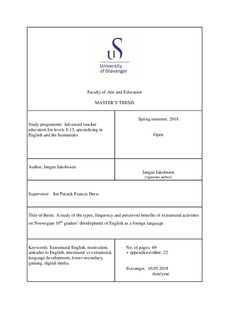| dc.description.abstract | This thesis is about extramural English activities among 10th graders in Norwegian lower secondary schools. The aim of the thesis was to map the 10th graders’ use and influence of extramural English activities, the types and frequency of extramural English activities they engaged in, their attitudes toward English as both a language and a subject, where the pupils believed they learned most English from, and to see if any correlation between these factors and their oral and written grades in English could be found. Identifying similarities and differences based on gender was also an integral part of the research. In addition, how the pupils perceived the benefits of these activities for their English language development. Additionally, how they compared the influence of extramural English to intermural English was mapped.
A mixed methods approach with a digital questionnaire and a set of focus-group interviews were used to gather the data. The questionnaire was answered by 105 10th graders from two different schools in a metropolitan area on the south-west coast of Norway. The focus group interviews were conducted with four groups of four participants, two groups from each school. The questions were heavily influenced by Sundqvist (2009), and can be seen as a follow-up of the research done there.
The pupils spent on average about 14 hours on extramural English per week, although this number may be influenced by the reported numbers being exaggerated. Gaming was the activity which scored highest on the frequency of extramural activities, whilst reading scored lowest. The pupils also frequently spent time on movies, TV-shows and music. The data shows a strong correlation between the participants’ use of extramural English activity, their attitudes toward the subject, and their grades. Furthermore, they claimed that they learned most English extramurally rather than in school.
This thesis, apparently being among the first of its kind in Norway, contributes to a field of study that may influence classrooms greatly. Extramural English has been identified as a major influence on language acquisition, and, if used correctly, may benefit pupils and teachers in English educational situations. By having mapped a group of 105 10th graders’ use of extramural English, the data may be used in future research on the field. This data adds to other research, especially in the Swedish context (Sundqvist, 2009; Sundqvist & Sylvén, 2016). | nb_NO |

